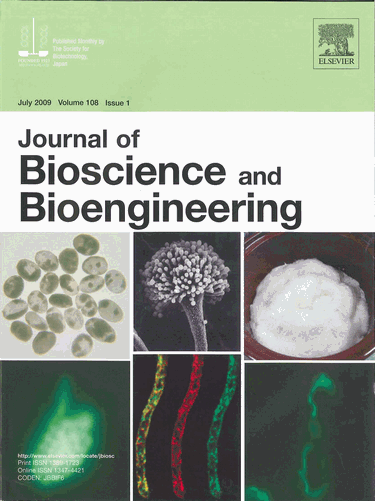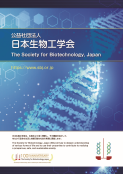Journal of Bioscience and Bioengineering Vol. 108 (2009)
Vol. 108 (July-December 2009)
Sake is the Japanese traditional alcohol beverage. Two microbes, Aspergillus oryzae and Saccharomyces cerevisae, are utilized for brewing of sake from steamed rice.
Upper-left: Scanning electron micrograph of a conidial head in A. oryzae.
Upper-middle: Photograph of koji (steamed rice cultivated with A. oryzae). The photo of koji was kindly provided by Saga Prefectural Sake Brewers Guild.
Upper-right: Photograph of sake mash into which koji, steamed rice and S. cerevisiae are added.
Researches on the role of organelles of these microbes in sake brewing is now providing novel and critical insights into the technologies of sake brewing, and of general fermentation industries. Two fluorescent figures are representatives of these researches.
Lower-left: Dynamic morphology of Endoplasmic reticulum (ER) in A. oryzae. Fluorescent images show the ER morphologies at two time points (0 s and 30 s represented in green and red, respectively).
In the overlaid image green and red colors out of the co-localized yellow areas reveal the ER motility. This dynamic behavior of the ER may support vigorous filamentous growth and high ability of enzyme production in A. oryzae.
Lower-right: Morphology of mitochondria in S. cerevisiae during sake brewing. Tubular image is the mitochondrial morphology of wild type strain, and networked image is the mitochondrial morphology of fis1 disruptant, which produces an increased amount of malate. Malate exhibits a crispy sour taste, which is an important taste component in sake.
The image by Dr. Hiroshi Kitagaki at the Saga University, Prof. Katsuhiko Kitamoto and Dr. Jun-ichi Maruyama at The University of Tokyo was selected as the winner in the JBB Cover Contest. The JBB editorial board and journal staff would like to thank all participants of the contest for their contributions.
⇒JBBアーカイブ:Vol.107 (2009) ~最新号
⇒JBBアーカイブ:Vol. 93(2002)~Vol. 106(2008)



.gif)